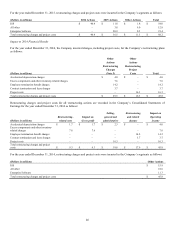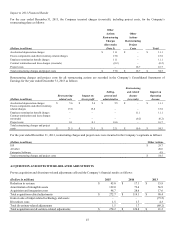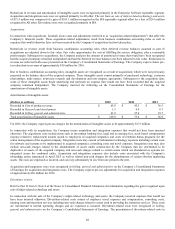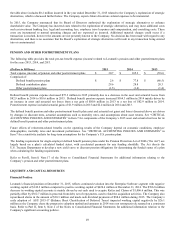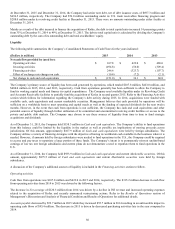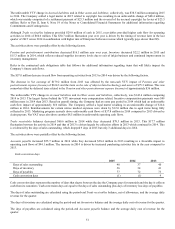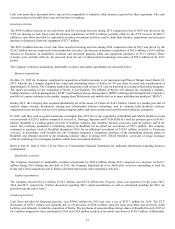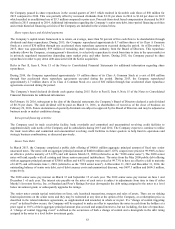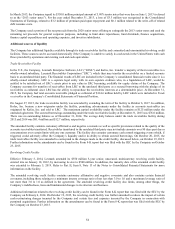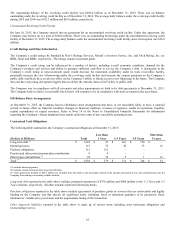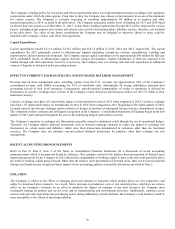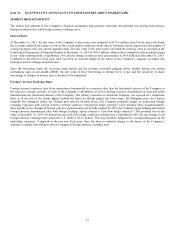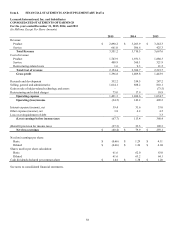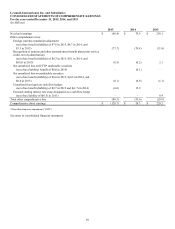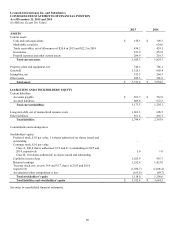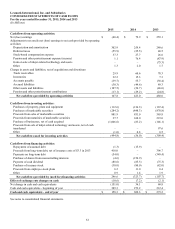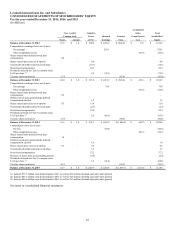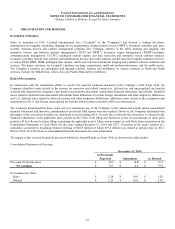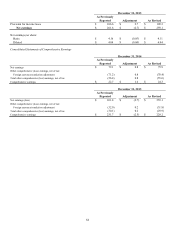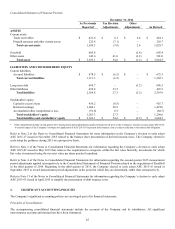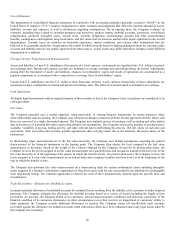Lexmark 2015 Annual Report Download - page 60
Download and view the complete annual report
Please find page 60 of the 2015 Lexmark annual report below. You can navigate through the pages in the report by either clicking on the pages listed below, or by using the keyword search tool below to find specific information within the annual report.56
The Company’s funding policy for its pension and other postretirement plans is to fund minimum amounts according to the regulatory
requirements under which the plans operate. From time to time, the Company may choose to fund amounts in excess of the minimum
for various reasons. The Company is currently expecting to contribute approximately $9 million to its pension and other
postretirement plans in 2016, as noted in the table above. The Company anticipates similar levels of funding for 2017 and 2018 based
on factors that were present as of December 31, 2015. Actual future funding requirements beyond 2016 will be impacted by various
factors, including actual pension asset returns and interest rates used for discounting future liabilities and are, therefore, not included
in the table above. The effect of any future contributions the Company may be obligated or otherwise choose to make could be
material to the Company’s future cash flows from operations.
Capital Expenditures
Capital expenditures totaled $112.6 million, $136.3 million and $167.4 million in 2015, 2014 and 2013, respectively. The capital
expenditures for 2015 principally related to infrastructure support (including internal-use software expenditures), building and
improvements and new product development. The Company expects capital expenditures to be approximately $80 million for full year
2016, attributable mostly to infrastructure support and new product development. Capital expenditures in 2016 are expected to be
funded through cash from operations; however, if necessary, the Company may use existing cash and cash equivalents or additional
sources of liquidity as discussed in the preceding sections.
EFFECT OF CURRENCY EXCHANGE RATES AND EXCHANGE RATE RISK MANAGEMENT
Revenue derived from international sales, including exports from the U.S., accounts for approximately 54% of the Company’s
consolidated revenue, with EMEA accounting for 35% of worldwide sales. Substantially all foreign subsidiaries maintain their
accounting records in their local currencies. Consequently, period-to-period comparability of results of operations is affected by
fluctuations in currency exchange rates. Certain of the Company’s Latin American and European entities use the U.S. dollar as their
functional currency.
Currency exchange rates had a 6% unfavorable impact on international revenue in 2015 when compared to 2014. Currency exchange
rates had a 1% unfavorable impact on international revenue in 2014 when compared to 2013. Beginning in the fourth quarter of 2014,
Lexmark entered into foreign exchange option contracts as hedges of portions of anticipated foreign currency denominated revenue.
The settlement of these contracts and subsequent recognition in the Company’s Consolidated Statements of Earnings began in the first
quarter of 2015 and continued throughout the year as the underlying hedged transactions occurred.
The Company’s exposure to exchange rate fluctuations generally cannot be minimized solely through the use of operational hedges.
Therefore, the Company utilizes financial instruments such as forward exchange contracts to reduce the impact of exchange rate
fluctuations on certain assets and liabilities, which arise from transactions denominated in currencies other than the functional
currency. The Company does not purchase currency-related financial instruments for purposes other than exchange rate risk
management.
RECENT ACCOUNTING PRONOUNCEMENTS
Refer to Part II, Item 8, Note 2 of the Notes to Consolidated Financial Statements for a discussion of recent accounting
pronouncements which is incorporated herein by reference. New guidance related to the balance sheet presentation of deferred taxes
adopted prospectively by the Company in 2015 affected the comparability of working capital to prior years and could materially affect
the trend of working capital going forward. Other than the balance sheet presentation of deferred taxes, there are no known material
changes and trends nor any recognized future impact of new accounting guidance beyond the disclosures provided in Note 2.
INFLATION
The Company is subject to the effects of changing prices and operates in industries where product prices are very competitive and
subject to downward price pressures. As a result, future increases in production costs or raw material prices could have an adverse
effect on the Company’s business. In an effort to minimize the impact on earnings of any such increases, the Company must
continually manage its product and service costs and its manufacturing and development processes. Additionally, monetary assets
such as cash and cash equivalents lose purchasing power during inflationary periods and thus, the Company’s cash balances could be
more susceptible to the effects of increasing inflation.


